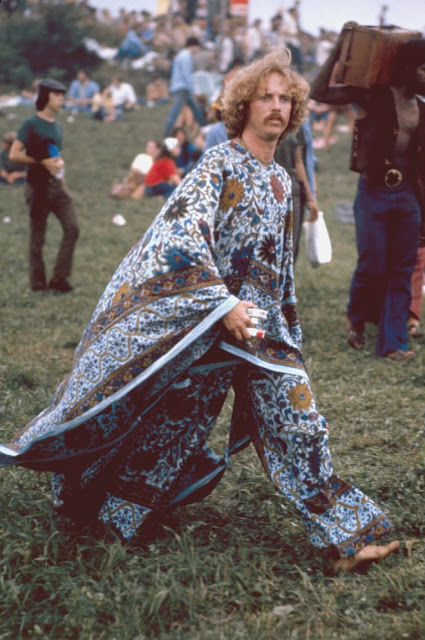These Wildly Eccentric—And Influential—Fashion Trends Rocked Woodstock
Free the nipple!
If the full-frontal nudity on glorious display at Woodstock shocked at the time, the desire to proudly show off your body—especially on hot August days—has come down to us in the panoply of unabashedly sheer garments, including rarefied examples from houses like Saint Laurent and Balenciaga, that continue to entice.
“Kerouac opened a million coffee bars and sold a million pairs of Levi’s to both sexes. Woodstock rises from his pages,” William S. Burroughs once opined. If it is difficult to imagine the curmudgeonly Burroughs, patron saint of the beat movement, enjoying himself at a music festival—he was invariably clad in a three-piece suit and a felt Homburg hat—the grumpy old man was nevertheless onto something. The beatniks of the 1950s, with On the Road author Jack Kerouac as their spiritual master, did indeed give rise to that million pair of unisex jeans—and a million other fashion trends that came to full, wildly eccentric flower at Woodstock, whose 48th anniversary is this weekend.
Nearly half a century later, these clothes have has come down to us with their power remarkably undiminished. Whenever we wake up in the morning and slip a bra top over our jeans, or rock a sheer blouse, or pop on a beloved vintage ensemble, we pay silent homage to the style of that seminal event.
Here, the fashion imperatives handed down from the mother of all music festivals.
Blur the genders!
Prior to the late 1960s, you would not have seen a college-age guy with flowers stuck in his hair, or holding back his flowing locks with a pastel headband across his forehead. Nor would you observe a fellow wrapped in a blanket that looked suspiciously like a dress, intended, perhaps, to ward off the famous wind and rain that blew through Woodstock. (As Grace Slick of Jefferson Airplane described it: “I didn’t see anybody play, except when I was standing backstage waiting to go on, because it was so muddy. And the weather was so horrible, you literally couldn’t get there except by helicopter.”)
Search the world!
Prior to the Woodstock generation, the repurposing of so-called “ethnic” clothing from all over the world was unimaginable. But by 1969, young people were topping Indian print tunics with Peruvian alpaca ponchos; African dashikis were making common cause with Pakistani trousers. (The debate surrounding cultural appropriation was still decades away.)
Celebrate loving hands at home!
Sometimes the biggest fashion innovations had their birth in the bathroom sink—the first tie-dyed garments were midwifed at home by twisting T-shirts and dunking them in a vat of RIT dye. Likewise, skills like crochet and macramé, previously confined to grandma doilies, were now employed for bra tops, their peekaboo holes enjoying a radical new destiny. (See free the nipple above.)
Embrace irony.
If “Don’t Trust Anyone Over 30” and “Turn On, Tune In, Drop Out” were the slogans of the era, a similar cynicism informed wardrobes. At the height of the peace movement, when activists were accused of flag-burning (sometimes with justification), the red, white, and blue showed up as skintight trousers; army jackets were often sported by anti-war activists. (Could it not be argued that all the absurd, ridiculous sayings decorating today’s T-shirts are the direct descendants of these styles?)
Attack the attic and the thrift shop.
The 1960s were the first time that people wore old clothes, used clothes, secondhand clothes and were utterly without shame! But of course, in the late 1960s those slinky 1940s frocks were only 20 years old, those exquisite beaded roaring ’20s frocks a mere 40. Embroidered peasant blouses, ready to be paired with low-slung bell-bottoms, could be had for $3 on the thrift shop rack—who could resist wearing this costume on the road to Bethel?


















Post a Comment